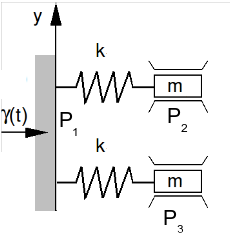1. Reference problem#
1.1. Geometry#
We calculate the response of a linear system composed of two masses and two independent springs to an acceleration imposed at their anchor point \({P}_{1}\):

We have \({P}_{1}{P}_{2}={P}_{1}{P}_{3}=1m\) distance.
1.2. Material properties#
connection stiffness: \({k}_{1}=100N/m\);
point masses: \(m=m({P}_{2})=m({P}_{3})=100\mathit{kg}\).
\(\text{5 \%}\) modal damping for all modes
1.3. Boundary conditions and loads#
The unknowns of displacement \(u\), speed \(\dot{u}\) and accelerations \(\ddot{u}\) that are discussed in this document are defined in the coordinate system relating to the training movement.
Boundary conditions
The only authorized movements are translations according to axis \(x\).
In the coordinate system relating to the imposed displacement, the point \({P}_{1}\) is embedded: \({u}_{x}={u}_{y}={u}_{z}=0\).
Loading
In the global frame of reference, the anchor point \({P}_{1}\) is subject to an imposed harmonic displacement of frequency \({f}_{\mathrm{ex}}\). The calculation is done from \(0\) to \(20s\) in the associated relative coordinate system.
1.4. Initial conditions#
The system is initially assumed to be at rest in the relative coordinate system: at \(t=0\), \({u}_{x}(0)=0\) and \(\dot{{u}_{x}}(0)=0\) at all points.